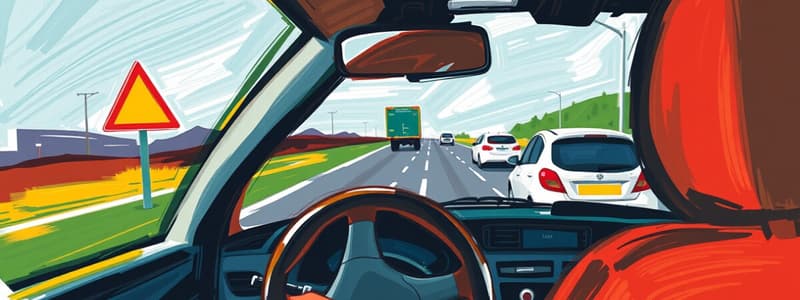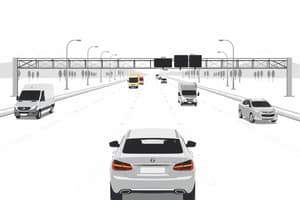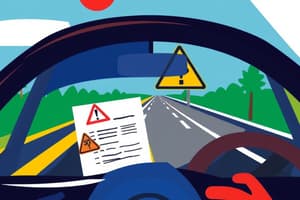Podcast
Questions and Answers
What are risk factors contributed by roadway and environment?
What are risk factors contributed by roadway and environment?
- Snow (correct)
- Ice (correct)
- Sharp curves (correct)
- Construction (correct)
The driving task is primarily a ____ task.
The driving task is primarily a ____ task.
thinking
When you apply the IPDE process, you may decide to ____.
When you apply the IPDE process, you may decide to ____.
change speed, change direction, or communicate with others
What is the Smith System?
What is the Smith System?
How many zones of space surrounding your vehicle are incorporated in the zone control system?
How many zones of space surrounding your vehicle are incorporated in the zone control system?
What does a closed zone mean?
What does a closed zone mean?
How many searching ranges need to be evaluated in your path of travel?
How many searching ranges need to be evaluated in your path of travel?
The process of searching critical areas of the traffic environment in a regular sequence is called ____.
The process of searching critical areas of the traffic environment in a regular sequence is called ____.
You should practice your orderly visual search pattern ____.
You should practice your orderly visual search pattern ____.
When you look far ahead as you drive, you are ____.
When you look far ahead as you drive, you are ____.
Scanning means to ____.
Scanning means to ____.
Searching for specific driving-related clues ____.
Searching for specific driving-related clues ____.
If you spot a parked car with front wheels turned toward the street and a person behind the wheel, you should ____.
If you spot a parked car with front wheels turned toward the street and a person behind the wheel, you should ____.
When you identify that a road is narrowing from a multi-lane to a single lane, you should ____.
When you identify that a road is narrowing from a multi-lane to a single lane, you should ____.
When you use the predict step in the IPDE process you ____.
When you use the predict step in the IPDE process you ____.
Making driving judgments involves ____.
Making driving judgments involves ____.
You are going to change direction, therefore you must ____.
You are going to change direction, therefore you must ____.
How can you prepare yourself to deal with the worst possible actions of other HTS users?
How can you prepare yourself to deal with the worst possible actions of other HTS users?
You compromise space when you ____.
You compromise space when you ____.
To compromise space means to ____.
To compromise space means to ____.
When you must handle several hazards at the same time, the best tactic is to ____.
When you must handle several hazards at the same time, the best tactic is to ____.
What is thinking out loud?
What is thinking out loud?
What happens if you lock the brakes when braking suddenly?
What happens if you lock the brakes when braking suddenly?
Communication with others to reduce risk in a possible conflict situation involves ____.
Communication with others to reduce risk in a possible conflict situation involves ____.
When braking in an emergency stop, you should ____.
When braking in an emergency stop, you should ____.
Flashcards
Roadway and Environmental Risk Factors
Roadway and Environmental Risk Factors
Conditions like construction, curves, snow, or ice that can affect driving.
The Driving Task
The Driving Task
Primarily a mental activity that requires constant assessment and decision-making.
IPDE Process
IPDE Process
Identify, Predict, Decide, Execute: A process for safe navigation.
Smith System
Smith System
Signup and view all the flashcards
Zone Control System
Zone Control System
Signup and view all the flashcards
Closed Zone
Closed Zone
Signup and view all the flashcards
Searching Ranges
Searching Ranges
Signup and view all the flashcards
Visual Search Patterns
Visual Search Patterns
Signup and view all the flashcards
Practicing Search Patterns
Practicing Search Patterns
Signup and view all the flashcards
Aiming High
Aiming High
Signup and view all the flashcards
Scanning Techniques
Scanning Techniques
Signup and view all the flashcards
Environment-Specific Clues
Environment-Specific Clues
Signup and view all the flashcards
Anticipating Vehicle Movement
Anticipating Vehicle Movement
Signup and view all the flashcards
Narrowing Roads
Narrowing Roads
Signup and view all the flashcards
Predicting Conflicts
Predicting Conflicts
Signup and view all the flashcards
Making Driving Judgments
Making Driving Judgments
Signup and view all the flashcards
Changing Direction
Changing Direction
Signup and view all the flashcards
Preparing for Mistakes
Preparing for Mistakes
Signup and view all the flashcards
Compromising Space
Compromising Space
Signup and view all the flashcards
Tactical Hazard Management
Tactical Hazard Management
Signup and view all the flashcards
Commentary Driving
Commentary Driving
Signup and view all the flashcards
Braking Techniques
Braking Techniques
Signup and view all the flashcards
Driver Communication
Driver Communication
Signup and view all the flashcards
Emergency Braking
Emergency Braking
Signup and view all the flashcards
Open Zone
Open Zone
Signup and view all the flashcards
Study Notes
Roadway and Environmental Risk Factors
- Risk factors include construction, sharp curves, snow, and ice which can affect driving conditions.
The Driving Task
- The driving task is predominantly a thinking task requiring continuous assessment and decision-making.
IPDE Process
- In the IPDE (Identify, Predict, Decide, Execute) process, drivers may need to change speed, change direction, or communicate with others to navigate effectively.
Smith System
- The Smith System is an organized method designed to help drivers cultivate good visual habits for safer driving.
Zone Control System
- There are 6 zones of space surrounding a vehicle, each requiring assessment for safe driving.
Closed Zones
- A closed zone is a space that is restricted due to limitations in visibility or pathway, necessitating caution from the driver.
Searching Ranges
- Three searching ranges must be evaluated while driving to ensure awareness of surroundings and potential hazards.
Visual Search Patterns
- An orderly visual search pattern involves systematically checking critical areas of the traffic environment for safety.
Practicing Search Patterns
- Practicing the orderly visual search pattern as a passenger enhances familiarity and skill in active driving.
Aiming High and Steering
- Looking far ahead while driving is referred to as aiming high, which aids in effective steering and navigation.
Scanning Techniques
- Scanning involves glancing quickly and continuously to stay aware of the driving environment.
Environment-Specific Clues
- Clues for driving-related decisions differ based on the environment and require context-aware searching.
Anticipating Vehicle Movement
- If a parked car has turned wheels and an occupant inside, it can be predicted that the vehicle may pull out into traffic.
Narrowing Roads
- Upon identifying a narrowing road from multiple lanes to a single lane, it is advisable to merge into the through lane promptly.
Predicting Conflicts
- The predict step in the IPDE process involves judging where potential conflicts with other road users may occur.
Making Driving Judgments
- Making driving judgments entails measuring, comparing, and evaluating traffic situations for informed decision-making.
Changing Direction
- When changing direction, ensure to leave yourself an escape route or "out" in case of unexpected obstacles.
Preparing for Mistakes
- Assume that other highway transportation system (HTS) users may make mistakes, preparing for worst-case scenarios.
Compromising Space
- Compromising space occurs when it is not possible to separate or minimize hazards, requiring cautious navigation.
Tactical Hazard Management
- When dealing with multiple hazards concurrently, adjusting speed and slowing down is the most effective tactic.
Commentary Driving
- Thinking out loud while driving is referred to as commentary driving, which can enhance awareness and decision-making.
Braking Techniques
- Locking the brakes during a sudden stop can lead to a loss of steering control, stressing the importance of proper braking methods.
Driver Communication
- Effective communication with other road users to mitigate risk involves ensuring that others are aware of your presence.
Emergency Braking
- During emergency stops, it is crucial to avoid locking the brakes to maintain vehicle control and safety.
Studying That Suits You
Use AI to generate personalized quizzes and flashcards to suit your learning preferences.




